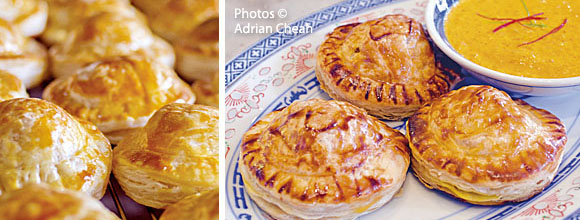Otak-otak, a savory parcel of fish custard

Unwrap a parcel of otak-otak and you will catch a waft of the spicy, delicious egg-like fish custard that is usually served with other dishes common in a Nyonya household. Otak-okak can also be eaten on its own or as an appetiser or even with bread. This popular dish is available at Nyonya restaurants, some food courts and wet markets, as well as a common spread in “Economy Rice” stalls.

Kebaya Restaurant at Seven Terraces has reinvented this dish as hors d'oeuvres and encase the otak-otak filling in puff pastry, serving it with a thick curry sauce on the side.
Derived from the Malay word “otak” which means “brains”, the texture of this fish mousse dish is soft and delicate. Penang’s version of otak-otak is encased within a banana leaf parcel and secured with a lidi or toothpick. One essential ingredient in this dish is daun kaduk, an aromatic plant that belongs to the paper family that is commonly used to wrap sireh. Coupled with lengkuas (galangal), fresh kunyit (turmeric) and kaffir lime leaves, all these herbs and spices lend the distinct flavour of this unique dish.

Thai influences on Penang food are significant because it distinguished Penang Nyonya food from that of Malacca and Singapore. This is prevalent in otak-otak which probably evolved from the Thai Hor Mok Pla (steamed fish curry) that is presented in a basket made from banana leaves. Most Thai restaurants here in Penang steam their version in a hollowed coconut shell and add prawns and squid to the mix.

Some pasar malam (night market) yet offer another version of this dish. Originating from the Southern states of Malaysia, the fish is minced and mixed with rempah, encased in narrow strips of two coconut leaflets and grilled over an open charcoal fire. It’s drier and has a rich smoky aroma.

My fish of choice for making this dish is "ngoh wa hu" (Threadfin / Ikan Selangin). If you are preparing this dish at home, you can also opt for other fish fillets. The rempah paste includes tumeric, lengkuas, lemongrass, garlic, shallots, dried and fresh chilies and grilled belacan (prawn paste); buah keras (candlenut) and grounded rice are added to thicken the paste; as well as pepper, sugar and salt to taste. The finely grounded paste is then added to beaten eggs, santan (coconut milk) and thinly sliced kaffir lime leaves, coating the fish generously before wrapping it in daun kaduk and then in banana leaves. Steaming takes about 20 minutes.
---------------------------------------------------------
Written and photographed by Adrian Cheah
© All rights reserved